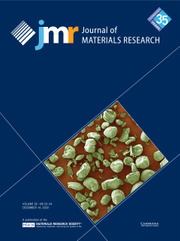Article contents
The 1430 cm−1 Raman line in single crystals of La2CuO4−y
Published online by Cambridge University Press: 31 January 2011
Abstract
The Raman line at 1430 cm−1 (M-line) in single crystal La2CuO4−y was studied as a function of doping, temperature, magnetic field, and excitation wavelength. Upon Li doping the line becomes broader, and it vanishes rapidly with Sr-doping. The line also broadens with increasing temperature and increasing applied magnetic field. Resonance enhancement was found for decreasing laser excitation energies but was not as pronounced as the enhancement of several alleged two-phonon lines. Many of these features are correlated with the 2D antiferromagnetic ordering measured in this system by neutron scattering. The possible identification of this line as a one-spin excitation is favored by the data though a two-phonon excitation is also considered.
Information
- Type
- Articles
- Information
- Copyright
- Copyright © Materials Research Society 1989
References
- 3
- Cited by

